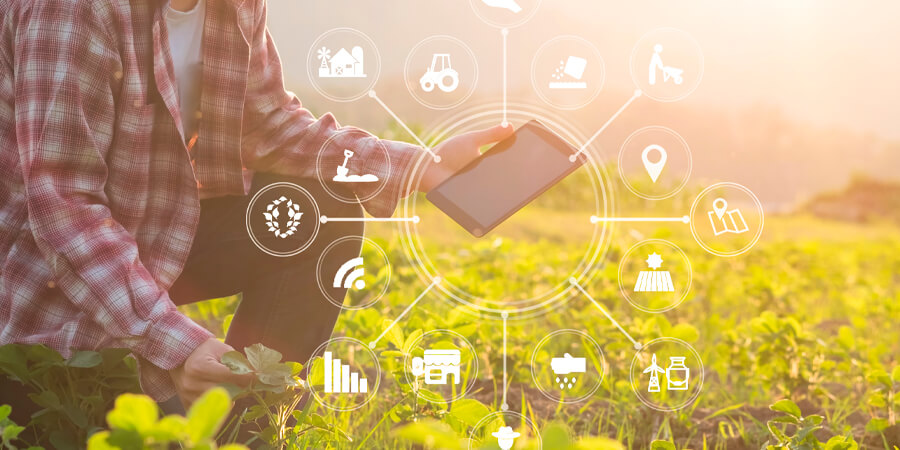Over the past 50 years, the agriculture industry has undergone a significant transformation. Farm equipment has become larger, faster and more productive because of technological advancements, allowing for the more effective cultivation of larger areas. Additionally, substantially enhanced seeding, irrigation and fertilizers have helped farmers boost harvests. Currently, agriculture is in the early stages of a new revolution that is driven by connectivity and data. Emerging technologies like artificial intelligence, analytics, networked sensors and others could boost yields even more, increase the effectiveness of water and other inputs, and foster sustainability and resilience in both agricultural production and livestock rearing.
The reduced travel and consumption during the COVID crisis presented sizable environmental benefits that will drive more local and sustainable sourcing moving forward, requiring modifications to companies' established, prepandemic practices. By 2050, the world's population is expected to reach 9.7 billion people, necessitating a 70% increase in the number of calories that are available for human consumption, even as the price of the ingredients used to produce those food sources rises. The current water supply won't be able to fulfill the world's water needs by 2030, and growing energy, labor and ingredient expenses are already putting pressure on profit margins. A quarter of the world's arable land has deteriorated and requires extensive repair/regeneration before it can support large-scale agriculture once again.
The Power of Technology in Agriculture
Nowadays, the agriculture sector is undergoing a technological transformation, which is helping farmers prosper in the digital age on many levels:
- Precision Farming: The era of conjecture on such advancements is over. Farmers can now improve their operations like never before thanks to technologies including cutting-edge sensors, drones and GPS technology. These advancements, which range from soil mapping to crop monitoring, aid in increasing yields, decreasing waste and preserving resources. Farmers can use such data-driven insights to guide their decision-making like never before.
- Vertical Farming: This development is becoming more popular as urbanization rises and represents a true game-changer. Farmers can produce crops indoors using hydroponic or aquaponic systems, which use less land and allow for year-round production. Fresh, regionally cultivated food is always available thanks to this sustainable strategy.
- Smart Irrigation: Global worries continue around water scarcity, but technology again can save the day! Farmers can monitor soil moisture levels in real time and use accurate irrigation methods with IoT-enabled equipment. In addition to improving crop health and resource allocation, these technologies also conserve water, allowing farmers to tend their land sustainably.
- Robotic Farming: Farmers are getting more and more assistance from robots in their fields. These autonomous machines are capable of carrying out duties like planting and harvesting, even determining the health of the crops and plants. They enable farmers to concentrate on advanced decision-making and increase total output by eliminating manual work and boosting efficiency. Welcome our mechanical allies in the field!
- Mobile Apps for Farmers: We now have access to more resources and knowledge about farming thanks to technology. Mobile apps offer real-time information and professional advice on everything from weather forecasts to pest treatment. Farmers are able to easily analyze market trends, communicate with suppliers and manage their finances, all in the palm of their hands.
Farmers can increase output, save resources and guarantee food security for a growing global population by utilizing the potential of these breakthroughs.
Continuing Obstacles in Agricultural Industry
The industry still faces major challenges, however. The creation of connectivity infrastructure is crucial, particularly in places that lack it. Farms have been hesitant to introduce digital tools in areas where connectivity infrastructure already exists since their effectiveness has not been sufficiently established.
The COVID pandemic's aforementioned environmental benefits from decreased travel and consumption are likely to prompt companies to make necessary adjustments to their established methods. Indeed, the crisis has highlighted the need for greater automation and digitization, while abrupt changes in demand and sales channels have highlighted the importance of flexible adaptability.
In recent years, many farmers have started using data in critical elements like soil, crops, livestock and weather. However, few of their counterparts in rural, disconnected areas have had equal access to these cutting-edge digital technologies that could aid in delivering worthwhile and actionable insights. Presently, in these less developed areas, practically all farm work is done by hand and requires little to no modern technology. This will undoubtedly change, and their technology needs will certainly grow as the agriculture industry becomes more connected worldwide moving forward.








